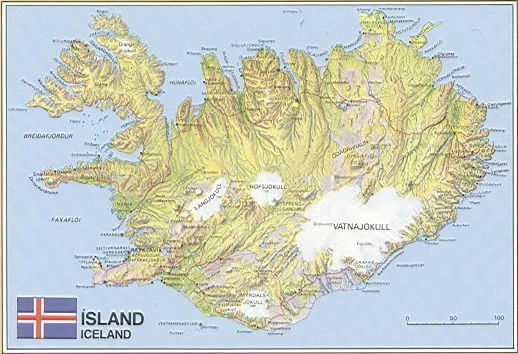
[] Iceland was settled by the Vikings in the 9th century. These Norse seafarers were heroes in the great Icelandic sagas written during medieval times. Iceland came under Denmark’s rule in the late 14th century. During the 18th century, a smallpox epidemic killed a third of the population, and a volcanic eruption devastated the country. Iceland survived, lending itself to United States and British military bases during World War II. Declared a republic in 1944, post-war Iceland became a charter member of NATO in 1949. Iceland elected Vigdis Finnbogadottir its first woman president in 1980, securing representation for the Woman’s Alliance Party. The highly literate population is 100 percent Icelandic, due to a ban on immigration. The country boasts low crime rates (the prison population is around 100) but is unable to break its economic dependence on fish. Iceland's Althing is the world's oldest parliament.
[]SPECIAL FACT Every Icelander in the country is listed in the telephone book under her or his first name.
[] For every square mile of land on this island nation, there are on average only five people. Iceland lies in the North Atlantic, about 560 mi (902 km) west of Norway and 185 mi (298 km) southeast of Greenland. The extraordinary landscape includes glaciers, hot springs, volcanoes, lava deserts, tundras, and snow-capped mountains that reach to nearly 7,000 ft (2,128 m) at their highest point. The high cliffs are home to some of the most dense colonies of sea birds in the world. The climate is cool but comparatively mild for the country’s latitude. The capital and largest city is Reykjavík, in the southeast. Iceland has three national parks and a number of other nature and wildlife reserves.
[] SPECIAL FACT Iceland is often referred to as the “Land of Fire and Ice.” About one-tenth of the country is covered by glaciers, and there are about 200 volcanoes (some still active) and more than 250 hot springs.
[] One of the most homogeneous populations in the world, are primarily the descendants of Norwegian settlers who arrived in the late 800s. Some of the Norwegian settlers were Vikings-dreaded, seafaring raiders and maritime traders. Iceland’s homogeneity is reflected in its language, which has changed so little from the old Norse language of the first settlers that most Icelanders can still read the thousand-year-old Viking sagas with ease. Literature, especially the saga or epic, has dominated Icelandic culture. Sagas are typically divided into three groups: the family saga, the historical saga, and the fictional saga. Sagas and epics have had a lasting effect on Icelandic literature, and many modern authors have continued to draw inspiration from the tradition. In 1955, writer Halldór Kiljan Laxness won the Nobel Prize for Literature. The Nobel committee cited his historical trilogy, “The Bell of Iceland,” and praised his “epic narrative power.”
[] SPECIAL FACT Iceland is the most sparsely populated country in Europe. Almost four-fifths of the country are uninhabited and most of the land is uninhabitable.
[] Iceland Republic of Iceland ECONOMICS Commercial fishing is the cornerstone of Iceland’s economy. Icelanders boast that their fisheries are the most efficient in the world. Cod, capelin, and other fish products account for more than 75 percent of exports. About 12 percent of the workforce is employed in the fishing industry. Another 12 percent works in manufacturing. Iceland’s industries produce metals and alloys such as aluminum, ferrosilicon, and diatomite (made from skeletons of one-celled algae called diatoms and used as filters). Other manufactured items range from fertilizers and cement to household items like clothing, furniture, and books. Industrial products account for 17 percent of exports. Sixty percent of Iceland’s workforce is employed in commerce, transportation, and services. In fact, the national airline, Icelandair, or Flugleidir, is Iceland’s largest single employer. Unemployment was virtually unknown to Icelanders until the late 1980s, when a drop in world fish prices sparked a recession. By 1996, the unemployment rate had risen to 4 percent. Less than 1 percent of the land is arable, and only 4 percent of the workforce is employed in farming activities. Iceland’s main agricultural crops are potatoes, turnips, and hay, which are used as feed for sheep and cattle.
[] SPECIAL FACT Icelanders pay a 41.84 percent income tax, among the highest in Europe. In return, citizens benefit from an extensive welfare system, excellent public education, and state-supported health care.
Information taken from Comptons 3D World Atlas Deluxe.